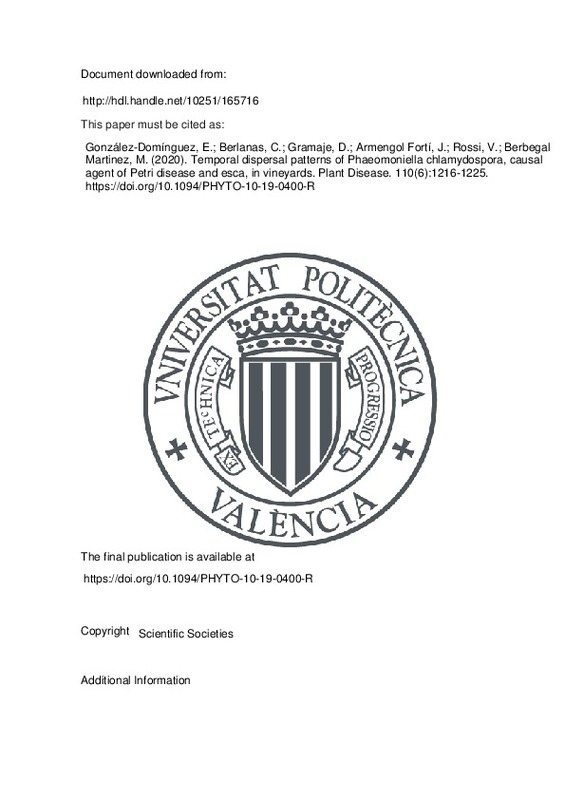JavaScript is disabled for your browser. Some features of this site may not work without it.
Buscar en RiuNet
Listar
Mi cuenta
Estadísticas
Ayuda RiuNet
Admin. UPV
Temporal dispersal patterns of Phaeomoniella chlamydospora, causal agent of Petri disease and esca, in vineyards
Mostrar el registro sencillo del ítem
Ficheros en el ítem
| dc.contributor.author | González-Domínguez, Elisa
|
es_ES |
| dc.contributor.author | Berlanas, Carmen
|
es_ES |
| dc.contributor.author | Gramaje, David
|
es_ES |
| dc.contributor.author | Armengol Fortí, Josep
|
es_ES |
| dc.contributor.author | Rossi, Vittorio
|
es_ES |
| dc.contributor.author | Berbegal Martinez, Monica
|
es_ES |
| dc.date.accessioned | 2021-04-28T03:31:43Z | |
| dc.date.available | 2021-04-28T03:31:43Z | |
| dc.date.issued | 2020-04-16 | es_ES |
| dc.identifier.issn | 0191-2917 | es_ES |
| dc.identifier.uri | http://hdl.handle.net/10251/165716 | |
| dc.description.abstract | [EN] Although the fungus Phaeomoniella chlamydospora is the most commonly detected causal agent of Petri disease and esca, two important fungal grapevine trunk diseases, little is known about the dispersal patterns of P. chlamydospora inoculum. In this work, we studied the dispersal of P. chlamydospora airborne inoculum from 2016 to 2018 in two viticultural areas of eastern (Ontinyent) and northern (Logroño) Spain. The vineyards were monitored weekly from November to April using microscope slide traps, and P. chlamydospora was detected and quantified by a specific real-time quantitative (qPCR) method set up in this work. The method was found to be sensitive, and a good correlation was observed between numbers of P. chlamydospora conidia (counted by microscope) and DNA copy numbers (quantified by qPCR). We consistently detected DNA of P. chlamydospora at both locations and in all seasons but in different quantities. In most cases, DNA was first detected in the last half of November, and most of the DNA was detected from December to early April. When rain was used as a predictor of P. chlamydospora DNA detection in traps, false-negative detections were observed, but these involved only 4% of the total. The dispersal pattern of P. chlamydospora DNA over time was best described (R2 = 0.765 and concordance correlation coefficient = 0.870) by a Gompertz equation, with time expressed as hydrothermal time (a physiological time accounting for the effects of temperature and rain). This equation could be used to predict periods with a high risk of dispersal of P. chlamydospora | es_ES |
| dc.description.sponsorship | Financial support for carrying out this research was provided by transnational funding bodies, being partners of the H2020 ERA-net project, CORE Organic Cofund, and the Cofund from the European Commission (PCI2018-093015/Project BIOVINE). Part of the research was funded by CAR (Government of La Rioja, Spain), project number R-03-16. C. Berlanas was supported by the FPI-INIA program from the INIA. D. Gramaje was supported by the Ramon y Cajal program, Spanish Government (RYC-2017-23098). Financial support for C. Berlanas during her 1-month stay at Universitat Polit`ecnica de Val`encia was provided by the Viticulture Research Network RedVitis (AGL2015-70931-REDT) | es_ES |
| dc.language | Inglés | es_ES |
| dc.publisher | Scientific Societies | es_ES |
| dc.relation.ispartof | Plant Disease | es_ES |
| dc.rights | Reserva de todos los derechos | es_ES |
| dc.subject | Ecology and epidemiology | es_ES |
| dc.subject | Grapevine trunk diseases | es_ES |
| dc.subject | Hydrothermal time | es_ES |
| dc.subject | Mycology | es_ES |
| dc.subject | Real-time quantitative PCR | es_ES |
| dc.subject | Vitis vinifera | es_ES |
| dc.subject.classification | PRODUCCION VEGETAL | es_ES |
| dc.subject.classification | BOTANICA | es_ES |
| dc.title | Temporal dispersal patterns of Phaeomoniella chlamydospora, causal agent of Petri disease and esca, in vineyards | es_ES |
| dc.type | Artículo | es_ES |
| dc.identifier.doi | 10.1094/PHYTO-10-19-0400-R | es_ES |
| dc.relation.projectID | info:eu-repo/grantAgreement/MINECO//AGL2015-70931-REDT/ES/RED DE INVESTIGACION EN VITICULTURA/ | es_ES |
| dc.relation.projectID | info:eu-repo/grantAgreement/AEI//RYC-2017-23098/ | es_ES |
| dc.relation.projectID | info:eu-repo/grantAgreement/Gobierno de La Rioja//R-03-16/ | es_ES |
| dc.relation.projectID | info:eu-repo/grantAgreement/AEI//PCI2018-093015/ES/APROVECHAR LA BIODIVERSIDAD EN LOS SISTEMAS VITICOLAS PARA REDUCIR LAS PLAGAS Y EL USO DE PLAGUICIDAS, MEJORANDO LOS SERVICIOS PROPORCIONADOS POR EL PROPIO ECOSISTEMA/ | es_ES |
| dc.rights.accessRights | Abierto | es_ES |
| dc.contributor.affiliation | Universitat Politècnica de València. Instituto Universitario de Tecnología Nanofotónica - Institut Universitari de Tecnologia Nanofotònica | es_ES |
| dc.contributor.affiliation | Universitat Politècnica de València. Instituto Agroforestal Mediterráneo - Institut Agroforestal Mediterrani | es_ES |
| dc.contributor.affiliation | Universitat Politècnica de València. Departamento de Ecosistemas Agroforestales - Departament d'Ecosistemes Agroforestals | es_ES |
| dc.description.bibliographicCitation | González-Domínguez, E.; Berlanas, C.; Gramaje, D.; Armengol Fortí, J.; Rossi, V.; Berbegal Martinez, M. (2020). Temporal dispersal patterns of Phaeomoniella chlamydospora, causal agent of Petri disease and esca, in vineyards. Plant Disease. 110(6):1216-1225. https://doi.org/10.1094/PHYTO-10-19-0400-R | es_ES |
| dc.description.accrualMethod | S | es_ES |
| dc.relation.publisherversion | https://doi.org/10.1094/PHYTO-10-19-0400-R | es_ES |
| dc.description.upvformatpinicio | 1216 | es_ES |
| dc.description.upvformatpfin | 1225 | es_ES |
| dc.type.version | info:eu-repo/semantics/publishedVersion | es_ES |
| dc.description.volume | 110 | es_ES |
| dc.description.issue | 6 | es_ES |
| dc.identifier.pmid | 32129711 | es_ES |
| dc.relation.pasarela | S\416975 | es_ES |
| dc.contributor.funder | Gobierno de La Rioja | es_ES |
| dc.contributor.funder | Agencia Estatal de Investigación | es_ES |
| dc.contributor.funder | Ministerio de Economía y Competitividad | es_ES |
| dc.subject.ods | 02.- Poner fin al hambre, conseguir la seguridad alimentaria y una mejor nutrición, y promover la agricultura sostenible | es_ES |







![[Cerrado]](/themes/UPV/images/candado.png)

